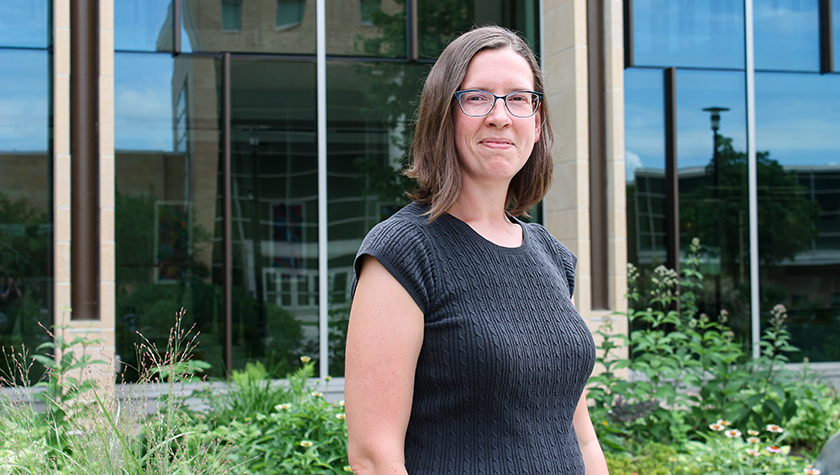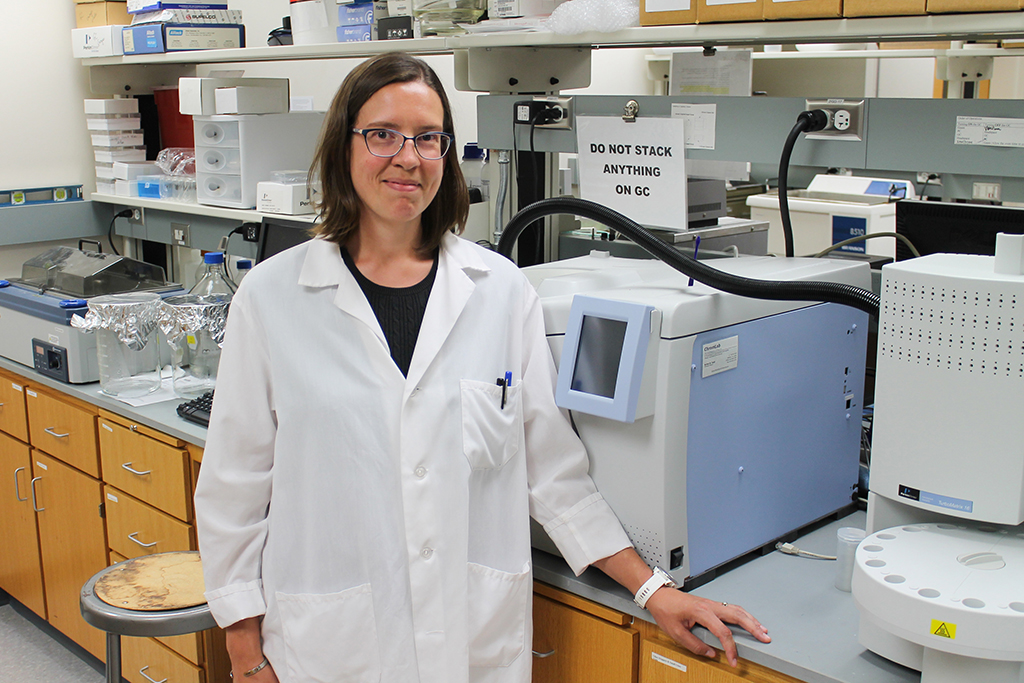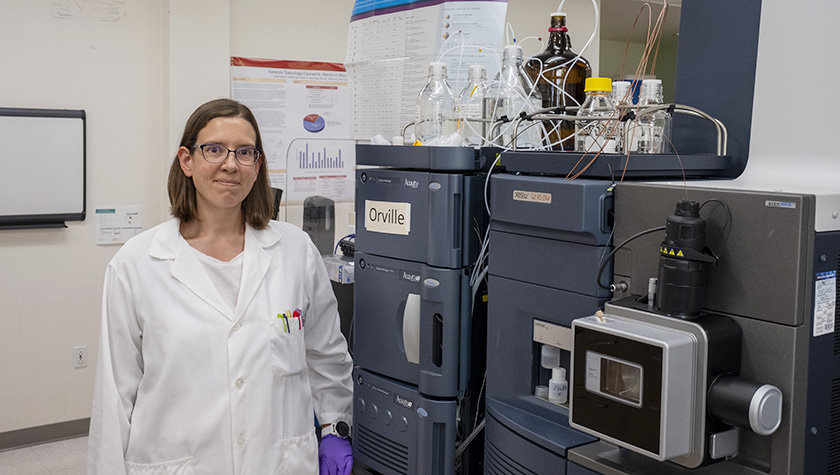
Through a National Institute of Justice grant, Assistant Professor Heather Barkholtz aims to tease out the toxicological difference between mirror-image meth isomers
By Susan Smith
In a rather unusual Wisconsin court case, a defendant who had been arrested for impaired driving argued that the methamphetamine found in their system was due to use of an over-the-counter nasal spray. The case caught the attention of Heather Barkholtz, an assistant professor of pharmaceutical sciences at the University of Wisconsin–Madison who specializes in the detection and action of drugs of abuse.
It turns out some sinus-clearing sprays contain levmetamfetamine, the R-isomer of methamphetamine and a mirror image of the S-isomer, which is available as a pill to treat ADD/ADHD but is also the primary component of illicit meth. Isomers are molecules with the same chemical formula but different arrangements of atoms, leading to different effects. While they both can have legitimate medical uses, they also have abuse potential, and even over-the-counter medicines can be misused and cause impairment.
“The judge was very interested in why we weren’t separating the two isomers,” said Barkholtz, a forensic toxicologist who has a joint appointment between the School of Pharmacy and the Wisconsin State Laboratory of Hygiene. And she got interested, too.
“I like it when research leaves the lab. I want to leverage analytical chemistry for things that have a direct impact on public health.”
—Heather Barkholtz
“It sparked our curiosity about what we do and don’t know,” she says. Barkholtz and colleagues did a literature review, and found that very little research had been done on the R-isomer — which is a problem since workplace drug testing, criminal investigations, and post-mortems rely on tests that often don’t separate the isomers. Existing studies of the R-isomer, which is a less potent stimulant, had only looked at 99 research subjects.
“A paucity of literature exists on the pharmacology of R-methamphetamine in humans,” they wrote. “This knowledge gap is problematic.”
The National Institute of Justice (NIJ) agreed and awarded Barkholtz a $1.04 million grant to develop more accurate tests for crime laboratories to use.
“We’re excited that NIJ funded it,” she said. “This study has direct implications for forensic toxicology, which has direct applications to criminal justice, so the NIJ has been an amazing partner for this work.”
Untangling legal from illicit
The NIJ noted that more than a million people a year are suspected of driving with methamphetamine in their systems.
On the other hand, Barkholtz says, “If someone is just using nasal inhalers as the manufacturer intended, we don’t want to see that prosecuted.”

Current Wisconsin law bans driving while under the influence of methamphetamine, without specifying which isomer.
“Since the R-isomer is not a potent stimulant, we would like to know the amount of S- versus R-isomer meth, if the latter is present at all, in impaired drivers,” Barkholtz says.
Barkholtz is exploring whether isomer-specific tests based on blood, plasma, and saliva would be feasible. Another aim of the study is to understand how the two isomers differ in their impairment and metabolism.
“I’m super interested in how small structural changes in molecules affect the impairment profile and your body’s response to the molecule,” she says. “There’s some indication that consuming both R- and S-meth might have more than a one plus one impairment effect. How are they metabolized? Does this small change in structure affect metabolism?”
Since much of the meth on the street is created in clandestine “labs” with little quality control, street drugs also can contain both isomers.
Meth labs, Barkholtz says, “are producing drugs with no one looking over their shoulders. When meth labs are making profit-driven decisions, they’re not caring about the effects on health.”
Barkholtz’s research collaborator, addiction medicine specialist David Leinweber, is interested in understanding how methamphetamine is metabolized and broken down in the body.

“This study will increase our fundamental knowledge of the drug’s behavior,” says Leinweber, an assistant professor of family and community medicine in the UW School of Medicine and Public Health. “Gaining insights into this is crucial, as it may indirectly inform future approaches to managing and supporting individuals affected by methamphetamine use.”
Another of Barkholtz’s current studies looks at the intoxicating properties of the various cannabinoids found in cannabis or marijuana products. Current studies have yet to set dosing standards for these substances, including cannabinoids such as delta-8-THC that have complicated legal statuses and are thus sold as “legal” yet intoxicating substances.
In collaboration with Paul Hutson, professor in the School’s Pharmacy Practice and Translational Research Division, and David Leinweber, assistant professor in the UW School of Medicine and Public Health, she’s running a double blind, placebo-controlled pilot study comparing the effects of delta-9-THC isolates, delta-8-THC isolates, and a placebo in healthy volunteers. She’s hoping this leads to future funding to study an expanded suite of roadside impairment tests that officers can use to test for cannabis intoxication.
Chemistry for public health
Forensic science studies of marijuana and meth did not seem to be in Barkholtz’s future when she graduated from Northern Illinois University with a PhD in chemistry and a specialization in nanotechnology. Her postdoctoral work took her to Sandia National Laboratory in New Mexico, where she studied the safety and reliability of lithium-ion batteries used to store renewable energy.
While the work on green energy was interesting, she wanted her research to have a more direct impact on public health.

“I like it when research leaves the lab,” she says. “I want to leverage analytical chemistry for things that have a direct impact on public health.”
So when a job managing the breath alcohol program at the Wisconsin Department of Transportation came up, Barkholtz jumped at the chance to switch focus.
“We also really wanted to come home to Wisconsin,” says Barkholtz, a native of Oshkosh. In that job, Barkholtz worked with the State Patrol and other agencies who used “breathalyzer” field sobriety tests.
She worked there for four years, and in 2021 her dream job was created: a position combining the research expertise of the School of Pharmacy’s Pharmaceutical Sciences Division and the state-of-the-art analytical equipment and expert scientists at the Wisconsin State Laboratory of Hygiene (WSLH). It was the perfect fit for an analytical chemist who wants to work on issues important to public health.
“It’s amazing to work here because my research lab overlaps with the WSLH forensic toxicology section, and we can help fill gaps where they don’t have in-house expertise,” she says. “We have the flexibility to explore these spaces where there are gaps in our knowledge of impairing substances.”
Just as she did at the DOT, she interacts with law enforcement, especially officers who have had advanced training in field sobriety testing.
“The ideas for our study are often inspired by problems our colleagues are having in the field,” she says. “This helps us keep a fresh perspective as we try to make sure the work we do is translatable.”

